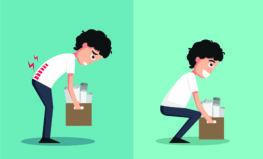
Back pain can be debilitating, interfering with your ability to work, get around, and enjoy your usual activities. Many back injuries occur in the workplace, even with light-duty jobs. Some of them result from wear and tear over time. However, there are several ways you can reduce your risk of back injuries at work.
To learn about back injury prevention and what you can do if you were injured at work, continue reading. If you have suffered a workplace back injury in Brownsville and need legal assistance, please contact Herrman & Herrman for a free consultation with a Brownsville back injury lawyer. Our knowledgeable team is available 24 hours a day, seven days a week, to answer your questions.
Common Causes of Back Pain at Work
When most people think of work-related back injuries, they picture trauma from heavy lifting. However, many jobs require activities that put significant strain on your back.
The common causes of work-related back pain include:
- Motor vehicle accidents – Many workers are required to drive motor vehicles or heavy machinery, which increases their risk of back injury from traffic collisions. A motor vehicle accident can cause back injuries through blunt-force trauma, crushing injuries, or penetrative injuries.
- Repetitive motion strain – Even low-stress repetitive motions can cause muscles to tighten and tear over time. Pain from repetitive motion strain or a wear-and-tear injury often appears gradually. While they occur gradually, these injuries can be debilitating and require surgery.
- Heavy lifting injuries – Overexertion from lifting heavy objects may cause back pain. Back injuries often occur when workers strain to lift heavy objects or twist their bodies while carrying heavy objects.
- Inadequate training – Employers need to provide proper safety training based on workers’ roles to reduce the risk of injury. This includes training workers in proper lifting techniques, safe ladder and equipment use, and good posture.
- Bad policies or safety standards – When companies do not prioritize safety, workers can get hurt. If employees are overworked or rushed because of staffing shortages or unreasonable production demands, they are more likely to injure themselves as a result.
- Unsafe equipment or machinery – If equipment or machinery is not properly maintained for workers, accidents can lead to back strain or injuries. Workers who sustain back injuries from equipment with manufacturing defects may have grounds for claims against the negligent manufacturer.
- Slip and fall accidents – A slip and fall accident can lead to fractured vertebrae, herniated discs, and other serious back injuries. Slip and falls often occur in the workplace due to slick surfaces, open ledges or scaffolds, and loose debris or objects along walkways.
- Poor posture or ergonomics – Workers who work in awkward positions or use chairs without proper ergonomic support are especially likely to damage spinal structures and experience back pain.
Ways to Prevent Back Pain at Work
The Occupational Safety and Health Administration (OSHA) guide to back injury prevention notes that many back injuries develop gradually due to repetitive microtrauma. Employers can reduce the risk of traumatic back injuries by promoting:
- Regular exercise – Exercising several times each week will strengthen your core and limbs, which can reduce your risk of back injury. To prevent lower back injury, try swimming, pelvic lifts, or rotational stretches.
- Proper posture and ergonomics – Maintaining proper posture when you are standing, sitting, walking, or lifting objects can dramatically reduce your risk of back injuries. Employers can help office workers avoid back injuries by providing supportive chairs and ergonomic furniture.
- Safe and reasonable policies – Employers can reduce the risk of back injuries and pain by keeping productivity quotas reasonable and allowing workers enough time to take proper rest breaks.
- Repetitive task modifications – If workers are expected to perform repetitive tasks, employers should allow modifications that limit the risk of injury. To avoid strain from repetitive lifting tasks, employees could use lifting devices or alternate between heavy-duty and light-duty work.
- Proper equipment use and maintenance – When workers don’t understand how to use equipment properly or the equipment is poorly maintained, injuries can occur. Employers can help prevent back injuries by encouraging proper equipment use and keeping equipment in good repair.
What to Do If I Was Injured at Work
If you sustained a back injury at work, you may be entitled to benefits from your employer’s workers’ compensation insurance policy. If your employer carries workers’ comp insurance, you could receive compensation even if you were at fault for your occupational back injury.
Workers’ compensation benefits are intended to pay for necessary medical expenses related to your injury. If you are unable to return to work for a significant period due to the injury, workers’ comp can also cover a portion of your lost wages.
If you have been injured in a workplace accident, you should:
- Seek immediate medical care – Some workers’ compensation benefits will only cover treatment from providers in a certified healthcare network. If your employer is part of a network, you can ask them for a list of approved providers.
- Report the injury to your employer – You should report your back injury to them as soon as possible. If you don’t notify your employer of the injury within 30 days, you may lose your right to claim workers’ compensation benefits.
- Follow your doctor’s treatment recommendations – One of the most important things you can do for your health is to follow your doctor’s orders. By following prescribed treatment regimens and attending follow-up appointments, you will maximize your potential for recovery and demonstrate to interested parties that you are taking your health seriously.
- Determine whether your employer has workers’ comp insurance – Texas is the only state in the U.S. that doesn’t require employers to carry workers’ compensation insurance. If you were injured at work and your employer does not provide workers’ compensation benefits, you should talk to a personal injury attorney about your legal options.
- File a claim with the Texas Division of Workers’ Compensation (DWC) – If your employer does not file for you, you can file a claim by sending a completed DWC Form-041 to the Texas DWC online, by mail, or by fax. You must submit this form within one year of the date of your initial back injury to claim workers’ comp benefits.
If you need assistance with understanding your legal options, an attorney at Herrman & Herman can help. An attorney can help you evaluate other options for pursuing the compensation you need. This could include filing a claim with a private insurance provider or filing a lawsuit against your employer.
Had a Back Injured at Work? Contact Us
If you’re suffering from back pain following an accident at work, you need a caring work injury lawyer to help you pursue fair financial compensation. With more than 100 years of combined experience, the Brownsville back injury lawyers of Herrman & Herrman have secured favorable results for more than 20,000 injured Texans.
When you’re ready for answers to your questions, we’re here. Call us today at (361) 882-4357 or contact us online for a free case review of your back injury claim. For your convenience, we have several offices in Texas, including Brownsville, Corpus Christi, McAllen, and San Antonio.








